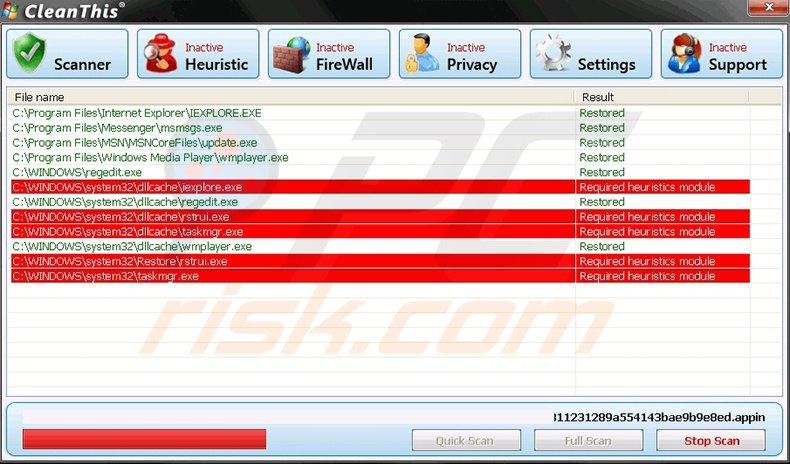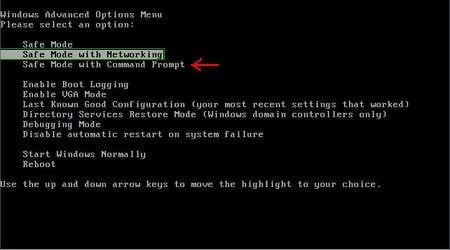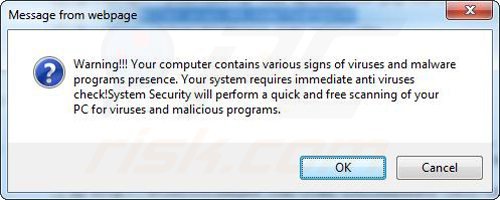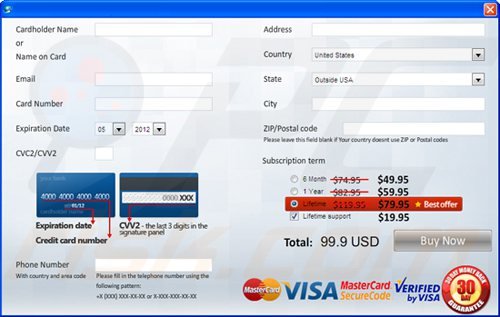Get free scan and check if your device is infected.
Remove it nowTo use full-featured product, you have to purchase a license for Combo Cleaner. Seven days free trial available. Combo Cleaner is owned and operated by RCS LT, the parent company of PCRisk.com.
What is CleanThis?
CleanThis is a fake computer security scanner created by Internet criminals with the intention of tricking computer users into purchasing a license for their rogue program. This bogus software is part of a fake Microsoft Security Essentials infection.
This rogue program is distributed through Trojans, and when it infects your system, it displays a fake MSE message stating that your computer is infected with an unknown Trojan and that you need to run a scan. A fake computer security scan will then begin.

Following the fake scan, you will be asked to download and install CleanThis to remove the computer infection. On restarting your computer, this bogus program takes over your desktop and performs various fake scans and displays fake security messages.
These actions are taken with the purpose of stealing money from your credit card.
Do not enter your banking information into this program - you will lose your money and your PC will remain infected. If you have already bought this fake scanner, you should contact your credit card company to explain that you have been tricked into purchasing a fake computer program.
On installation, CleanThis will imitate a security scan and report that it has detected multiple security issues on your system. You should not attempt to remove the indicated files manually, since these files are harmless.
CleanThis randomly selected them in an attempt to convince you that your computer is at risk. To further scare you into believing that your computer is infected, CleanThis generates security warning messages and asks you to activate a full version to remove the security issues.
You should not trust CleanThis - it is a malicious program and only an imitation of legitimate security software. Use the removal guide provided to help remove it from your PC.
The following fake security messages will be displayed:
"The application taskmgr.exe was launched successfully but was forced to shut down due to security reasons."
"This happened because the application was infected by a malicious program which might post a threat for the OS."
"It is highly recommended to install the necessary heuristic module and perform a full scan of your computer to exterminate malicious programs from it."
Instant automatic malware removal:
Manual threat removal might be a lengthy and complicated process that requires advanced IT skills. Combo Cleaner is a professional automatic malware removal tool that is recommended to get rid of malware. Download it by clicking the button below:
DOWNLOAD Combo CleanerBy downloading any software listed on this website you agree to our Privacy Policy and Terms of Use. To use full-featured product, you have to purchase a license for Combo Cleaner. 7 days free trial available. Combo Cleaner is owned and operated by RCS LT, the parent company of PCRisk.com.
Quick menu:
- What is CleanThis?
- STEP 1. Remove CleanThis using Safe Mode with Networking.
- STEP 2. Remove CleanThis manually by deleting files and registry entries.
CleanThis virus removal
DOWNLOAD remover for malware infections
Combo Cleaner checks if your computer is infected with malware. To use full-featured product, you have to purchase a license for Combo Cleaner. 7 days free trial available. Combo Cleaner is owned and operated by RCS LT, the parent company of PCRisk.com.
1. Use a clean computer: Download and save "fixregistrymse.reg" file to a portable USB device, CD, DVD...
2. Start your computer in Safe Mode. Click Start, click Shut Down, click Restart, click OK.
During your computer starting process press the F8 key on your keyboard multiple times until you see the Windows Advanced Option menu, then select Safe Mode with Networking from the list.{jcomments on}

Video showing how to start Windows in "Safe Mode with Networking":
Windows XP:
Windows 7:
Windows 8:
3. In the command prompt enter explorer.exe and press Enter on your keyboard. Your desktop should appear on the screen. Close the command prompt.
4. You should now fix your registry using the fixregistymse.reg that you saved before. Copy this file to your infected PC and double click it.
After this procedure, restart your computer.
5. Download legitimate anti-spyware software to fully remove CleanThis from your computer.
DOWNLOAD remover for malware infections
Combo Cleaner checks if your computer is infected with malware. To use full-featured product, you have to purchase a license for Combo Cleaner. 7 days free trial available. Combo Cleaner is owned and operated by RCS LT, the parent company of PCRisk.com.
If you are unable to remove CleanThis, you can use these manual removal instructions. Use them at your own risk, since if you do not have strong computer knowledge, you could harm your operating system.
Use them only if you are an experienced computer user. (Instructions on how to end processes, remove registry entries...)
End these CleanThis processes:
%Documents and Settings%\[User Name]\Application Data\gog.exe
%Documents and Settings%\[User Name]\Desktop\CleanThis.lnk
%Windows%\Tasks\At[random].job
Remove these CleanThis entries:
HKEY_CURRENT_USER\Software\Microsoft\Windows NT\CurrentVersion\Winlogon "Shell" = "%Documents and Settings%\[UserName]\Application Data\gog.exe"
HKEY_CURRENT_USER\Software\Microsoft\Windows\CurrentVersion\Run "CleanThis"
Delete these CleanThis files:
%Documents and Settings%\[User Name]\Application Data\gog.exe
%Documents and Settings%\[User Name]\Desktop\CleanThis.lnk
%Documents and Settings%\[User Name]\Start Menu\Programs\CleanThis.lnk
%Documents and Settings%\[User Name]\Application Data\[RANDOM CHARACTERS].bat
%Documents and Settings%\[User Name]\Application Data\gog.exe
%Windows%\Tasks\At[RANDOM CHARACTERS].job
Summary:
The fake antivirus programs (also known as "rogue antivirus programs" or "scareware") are applications that tries to lure computer users into paying for their non-existent full versions to remove the supposedly detected security infections (although the computer is actually clean). These bogus programs are created by cyber criminals who design them to look as legitimate antivirus software. Most commonly rogue antivirus programs infiltrate user's computer using poop-up windows or alerts which appear when users surf the Internet. These deceptive messages trick users into downloading a rogue antivirus program on their computers. Other known tactics used to spread scareware include exploit kits, infected email messages, online ad networks, drive-by downloads, or even direct calls to user's offering free support.
A computer that is infected with a fake antivirus program might also have other malware installed on it as rogue antivirus programs often are bundled with Trojans and exploit kits. Noteworthy that additional malware that infiltrates user's operating system remains on victim's computer regardless of whether a payment for a non-existent full version of a fake antivirus program is made. Here are some examples of fake security warning messages that are used in fake antivirus distribution:


Computer users who are dealing with a rogue security software shouldn't buy it's full version. By paying for a license key of a fake antivirus program users would send their money and banking information to cyber criminals. Users who have already entered their credit card number (or other sensitive information) when asked by such bogus software should inform their credit card company that they have been tricked into buying a rogue security software. Screenshot of a web page used to lure computer users into paying for a non-existent full version of cleanthis rogue and other rogue antivirus programs:

To protect your computer from cleanthis rogue and other rogue antivirus programs users should:
- Keep their operating system and all of the installed programs up-to-date.
- Use legitimate antivirus and anti-spyware programs.
- Use caution when clicking on links in social networking websites and email messages.
- Don't trust online pop-up messages which state that your computer is infected and offers you to download security software.
Symptoms indicating that your operating system is infected with a fake antivirus program:
- Intrusive security warning pop-up messages.
- Alerts asking to upgrade to a paid version of a program to remove the supposedly detected malware.
- Slow computer performance.
- Disabled Windows updates.
- Blocked Task Manager.
- Blocked Internet browsers or inability to visit legitimate antivirus vendor websites.
If you have additional information on cleanthis rogue or it's removal please share your knowledge in the comments section below.
Share:

Tomas Meskauskas
Expert security researcher, professional malware analyst
I am passionate about computer security and technology. I have an experience of over 10 years working in various companies related to computer technical issue solving and Internet security. I have been working as an author and editor for pcrisk.com since 2010. Follow me on Twitter and LinkedIn to stay informed about the latest online security threats.
PCrisk security portal is brought by a company RCS LT.
Joined forces of security researchers help educate computer users about the latest online security threats. More information about the company RCS LT.
Our malware removal guides are free. However, if you want to support us you can send us a donation.
DonatePCrisk security portal is brought by a company RCS LT.
Joined forces of security researchers help educate computer users about the latest online security threats. More information about the company RCS LT.
Our malware removal guides are free. However, if you want to support us you can send us a donation.
Donate
▼ Show Discussion